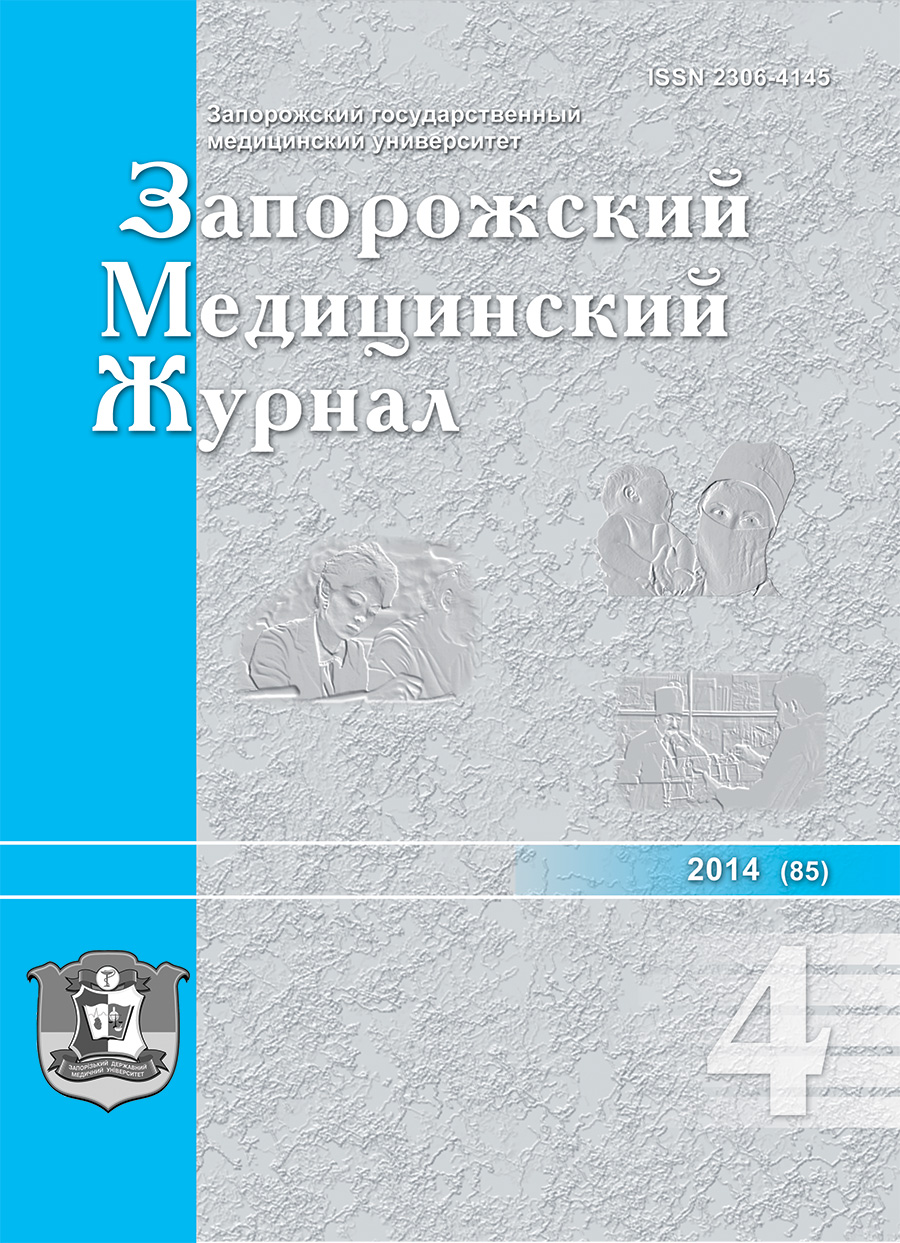Influence of visual load on the functional, hydrodynamic and biomechanical indicators of eye in children with different types of optical correction of myopia
DOI:
https://doi.org/10.14739/2310-1210.2014.4.27314Keywords:
Myopia, Intraocular Pressure, Accommodation, ChildrenAbstract
Questions of preference one or another type of optical correction of myopia in terms of stabilization of progression of the disease in children remain the subject of discussions and require further research.
The aim of research - to examine the effect of visual load on parameters of ophthalmotone, biomechanical parameters and accommodative function of the eye in children with various types of optical correction of myopia.
Materials and methods. We examined 40 children with myopia from 0.75 to 4.5 dpt, aged 7-14 years. I monitoring group - 23 children (46 eyes) passed course of orthokeratology more than 4-6 months. II monitoring group - 17 children (34 eyes) used glasses for correction. Control group - 15 children (30 eyes) was with emmetropia without ophthalmic pathology. Before and after 30-minute visual load at the computer reserves of relative accommodation were determined, with the use of the Ocular Response Analyzer, corneal-compensated intraocular pressure and corneal hysteresis.
Results. Initial level of corneal-compensated intraocular pressure and corneal hysteresis in patients with myopia of both groups did not differ, however, in relation to emmetropic eye (a control group) it was statistically significantly higher (p = 0.0003). Corneal hysteresis index was also significantly different in patients with myopia than in children with emmetropia (p <0.01). The lowest values of the relative accommodation were revealed in patients of II monitoring group - 1,95 ± 0,06 dpt (p <0.01) and almost the same in patients of I monitoring group and in patients with emmetropia (3,45 ± 0,07 dpt and 3,52 ± 0,08 dpt, respectively, p> 0.05).
After 30-minute visual load indicators of corneal-compensated intraocular pressure and pressure by Goldman in patients of I monitoring group and control group have increased insignificantly and amounted 15,8 ± 0,4 mm Hg; 16,5 ± 0,5 mmHg and 13,3 ± 0,3 mmHg; 15,3 ± 0,8 mmHg respectively. In children of II monitoring group, with glasses correction in response to visual load corneal-compensated intraocular pressure, and the pressure by Goldman to 17,3 ± 0,47 mmHg and 17,9 ± 0,45 mmHg (p <0.01) increased. The response of corneoscleral capsule of eyeball on visual load at a short distance was also different in patients. Thus, in patients of I monitoring group corneal hysteresis difference was not reliable and averaged 12,8 ± 0,2 (p> 0.05). In children with emmetropic refraction corneal hysteresis value was also not significantly changed - 13,7 ± 0,3 (p> 0.05). Significant reduction of corneal hysteresis occurs in the control group I to 11,4 ± 0,26 mmHg (p = 0.02).
The stock of relative accommodation after visual load in patients of I monitoring group did not change significantly and amounted 3,25 ± 0,06 dpt (p> 0.05), as well as in the control group - 3,49 ± 0,07 dpt (p> 0.05). In patients of II monitoring group the stock of relative accommodation authentically decreased to 0,92 ± 0,06 dpt (p <0.05).
Conclusion. In patients using orthokeratology lenses, after visual load a significant increase of corneal-compensated intraocular pressure lowering of corneal hysteresis and the stock of relative accommodation is only observed in 27% of cases, unlike children using glasses for correction, which in 88.2% cases observed deviation of these parameters by 1.2 times of the original data.
References
Avetisov, S. E. (2002) Blizorukost`. Moscow: Medicina. [in Russian].
Bushueva, N. N. (2012) Sovremennye aspekty patogeneza i lecheniya progressiruyuschej miopii [Modern aspects of the pathogenesis and treatment of progressive myopia]. Scientific Conf. children ophthalmologists Ukraine with international participation: Abstracts and lectures. Sevastopol`, (s.282–291). [in Ukrainian].
Zavgorodnyaya, N. G., & Barkovskaya, T. N. (1998) Izmenenie gidrodinamiki miopicheskogo glaza pod vliyaniem zritel`noj nagruzki i ee ro`l v progressirovanii zabolevaniyia [Change hydrodynamics myopic eyes under the influence of visual load and its role in disease progression]. Ophtal`mologicheskij zhurnal. 1, 31–35. [in Ukrainian].
Lapochkin, V. I. (1997) Ophtalmotonus miopicheskikh glaz: statisticheskaya ocenka i rol` v phormirovanii priobretennoj miopii [Ophthalmotonus myopic eyes: statistical evaluation and role in the formation of acquired myopia]. Vestnik oftal'mologii, 5, 20–25. [in Russian].
Strahov, V. V., & HulidovaE.H. (2011) Osobennosti progressirovaniya miopii na fone razlichnogo urovnya VGD [Features progression of myopia on the background of different levels of IOP]. Rossijskaya pediatricheskaya oftal'mologiya, 1, 15–19. [in Russian].
Aver`yanova, O. S., & Kovaljov, A. I. (2010) Kontrol' blizorukosti u podrostkov s pomoshh'yu refrakcionnoj terapii Paragon CRT: rezul'taty 4-kh letnegonablyudeniya [Myopia control in adolescents using Refractive Therapy Paragon CRT: results of a 4-year follow-up] Yubilejnaya nauchnaya konferenciya «Nevskie gorizonty – 2010», Proceedings of the Scientific Conference. Saint Petersburg, (p. 8–13). [in Russian].
Walline, J J., Jones, L. A., & Sinnott, L. T. (2009) Corneal reshaping and myopia progression. Br J Ophthalmol, 93, 1181–1185. doi: 10.1136/bjo.2008.151365.
Walline, J. J. (2012) Myopia control with corneal reshaping contact lenses. Invest. Ophthalmol. Vis. Sci., 53(11), 7086. doi: 10.1167/iovs.12-10996.
Downloads
How to Cite
Issue
Section
License
Authors who publish with this journal agree to the following terms:- Authors retain copyright and grant the journal right of first publication with the work simultaneously licensed under a Creative Commons Attribution License that allows others to share the work with an acknowledgement of the work's authorship and initial publication in this journal.

- Authors are able to enter into separate, additional contractual arrangements for the non-exclusive distribution of the journal's published version of the work (e.g., post it to an institutional repository or publish it in a book), with an acknowledgement of its initial publication in this journal.
- Authors are permitted and encouraged to post their work online (e.g., in institutional repositories or on their website) prior to and during the submission process, as it can lead to productive exchanges, as well as earlier and greater citation of published work (See The Effect of Open Access)

